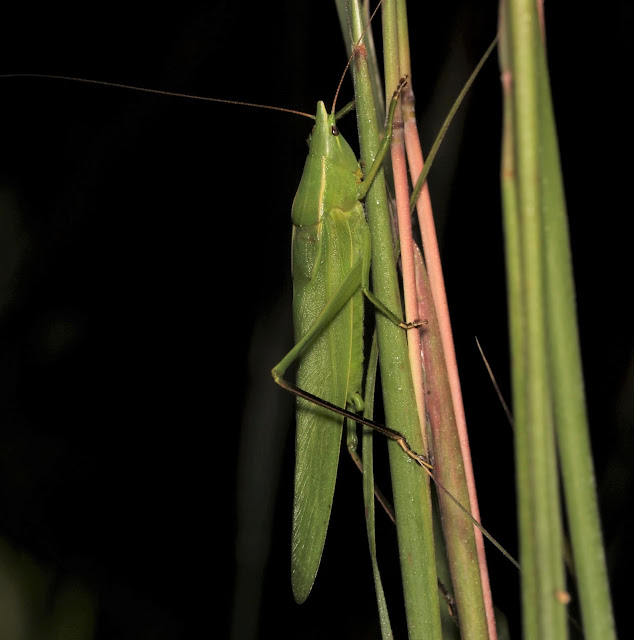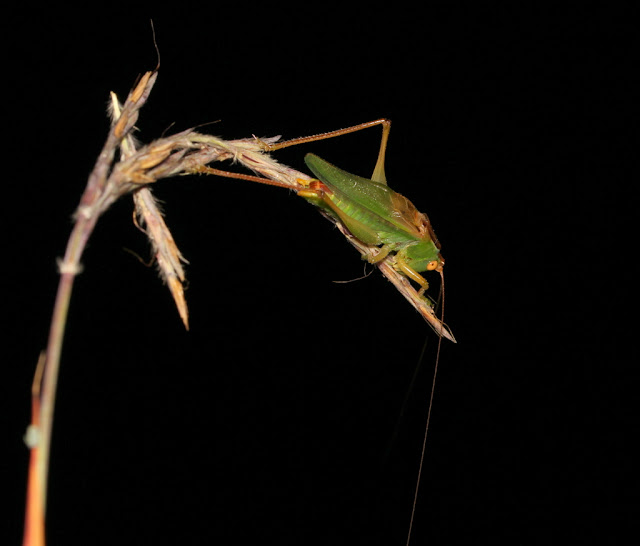I’m going to write a few posts this summer about crickets
and katydids in context. I’ve written about individual species and certainly
about range expansion, and I think it’s also very helpful to observe these insects as part of a habitat. What do they eat? Which other Orthopterans are in the habitat, and how
are they similar? Do those other species use the same plants? Is there any
similarity between their songs?
Let’s start with many people’s favorite katydid: the Sword-bearing Conehead.
First, you hear them.
Then, you attempt to find one. This could take a while
If and when you’re successful, I invite you to photograph him, but don’t move along just yet. You may know his song and his general appearance, but there’s so much more to observe!
First, what does he do while he’s singing? You might assume he’ll just stay in one position with his cone upright, but…
He can – and will – sing upside down and will parade up and down a stem without missing a single pulse of his ongoing song. I find this rather impressive.
Females as well as males will dine upside-down.
Try not to disturb them, though, because they’ll turn upside down and drop cone first into the grasses, never to be seen by you again.
And definitely admire the female's ovipositor. She’s the one that bears the sword!
Although the males sing almost tirelessly, both males and females spend a lot of time enthusiastically eating…seeds, seeds, and more seeds!
It’s fortunate that they have six legs, because they have to hold on to their stems while extricating those seeds. It’s fairly straightforward when they climb up a substantial grass stem with a seed head at the top, and upside down looks so effortless for them.
With patience and good fortune, you may be able to maneuver to the opposite side of the stem and actually watch them eat.
And that mouth!
Coneheads in Context
While every conehead is quite splendid in itself, it also is part of a broader context. What about their habitat? Other Orthopteran neighbors? Who else is singing, and how can we separate the songs?
While studying Sword-bearing Coneheads (or any other singing insect), notice the habitat and what other singing insects might share it. In this case, the habitat is usually an open field or meadow with grasses and quite possibly a mix of forbs such as goldenrod and asters as well. Remember, the male will need a fairly substantial stem for his singing perch.
When looking for a Sword-bearing Conehead, I’ll often find meadow katydid nymphs and adults. Slender Meadow Katydids mature in later July, as do the Sword-bearers. Tiny Short-winged Meadow Katydid nymphs will also be searching for seeds.
Why not see what you can learn about these neighbors? If they live in the same habitat, do they share similarities with the Sword-bearing Coneheads?
Slender Meadow Katydids may not have a prominent cone, but they, too can also perch, eat, and sing upside down. Their slender, green bodies and long, brown wings create an impressive blend with the grasses in which they live. They, too, love seeds!
Slender Meadow Katydid female (Conocephalus fasciatus)
In some areas, the habitat may be shared with Straight-lanced Meadow Katydids. Look at the female’s ovipositor – she’s carrying a substantial sword herself. And look at the little bump on this species’ head: it’s not quite a cone, but it looks like it could grow into one. These katydids live in grassy fields and are also seed-eaters.
Straight-lanced Meadow Katydid (Conocephalus strictus)
Male, above and female, below
Short-winged Meadow Katydids are also common in meadows, though they live in edge habitats as well. They're just as fond of seeds as the Slender and Straight-lanced Meadow Katydids and could certainly be found in the same vicinity as the Sword-bearing Coneheads. What I find especially charming about them is how boldly the nymphs climb all the way to the tops of big bluestem after dark so that they can reach the abundance of seeds far above the ground.
Short-winged Meadow Katydid female (Conocephalus brevipennis)
There are two Orchelimum meadow katydids you may find as well: Gladiator Meadow Katydids in the early summer and Common Meadow Katydids a little later. They are a little larger and heftier than those in the Conocephalus genus, but they appear and sound more similar than different.
Gladiator Meadow Katydids live in a somewhat wider range of habitats, as they can be found both in grassy meadows and in wetland edges. They are just as enamored with seeds as the other katydids we've visited.
Gladiator Meadow Katydid (Orchelimum gladiator)
Common Meadow Katydids are a possibility as well, though they are not as widespread in NE Ohio as our Gladiators. Common Meadow Katydids can be found in fields and meadows, but not typically near wetlands.
It's a nice collection of seed enthusiasts, and any of them may be found
singing and feasting with the Sword-bearing Coneheads.
And what is it about timothy, anyway? It’s a favorite among
coneheads and meadow katydids, but they’re not the only ones. I see meadow and edge habitat tree crickets - including nymphs – on timothy. Beetles. Bugs. I've even seen slugs up on timothy seed heads! If we're looking at and listening to the overall Sword-bearer habitat, why not see who else is sharing the dining room?
Let's focus next on the various meadow katydid songs and the
Sword-bearing Conehead’s song. Listen: are there similarities? I imagine you'll find the meadow katydids to be challenging to tell apart. Their songs are typically long repetitions of tics and/or whirrs that are fairly high in frequency (as in pitch, not occurrence). Let's do a comparison and you can see (or hear) what you think.
The meadow katydids are quite similar and the Sword-bearing Coneheads seem to blend in nicely with their continuous, high-frequency songs. Why are such similar songs heard in the same habitat? What makes them suitable for meadows and fields?
I'll compare these to some of the woodland and edge habitat katydids in the next post I write.
I’ll leave you with one more interesting fact about the
Sword-bearing Coneheads. Although they are generally green in my area (NE
Ohio), I have found a couple of brown forms as well. Some coneheads, such as
the Round-tipped, seem to occur in equal numbers of green and brown forms, but a
brown Sword-bearer is a rare treat in NE Ohio. The only two I have found in my area were at Bath Nature Preserve in Summit County. The first photo is a brown female with a rosy face. You'll see how the brown male in the second photo blends beautifully while hiding in the dried grasses.
Assisting with the second Ohio Breeding Bird Atlas taught me a great deal about watching and listening for behavior, relationships, and overall context. I approach singing insects in a similar way, and there are fascinating things to learn from any of them.
And what better place to start than coneheads and their seeds?



































